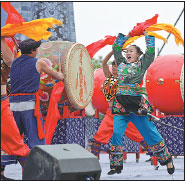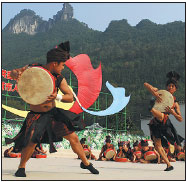Ethnic group passes down traditional drum dance
Playing drums is a popular activity among the Miao people in Jishou, Hunan province, and helps the ethnic group retain its history and culture.
The local drum performances are also called "drum dance" to reflect the Miao people's traditional dance while beating the drums. The dances often represent the daily life and work of the Miao people, such as sowing seeds, transplanting rice seedlings, washing the face and putting on clothes.
Shi Shunmin, 67, from Jishou, is a well-known drum queen and also an important conservator of Xiangxi Miao drum dancing, a national-level intangible cultural heritage item.
Shi began to learn to play drums when she was 8 years old, intrigued by her mother's drum dancing.
Shi performed Miao drum dances with her partners in the Great Hall of the People in Beijing in 1964 when she was just 15 years old. "The spectators liked the dances greatly and applauded us three times," Shi recalled.
After the performance, she met Chairman Mao and then-Premier Zhou Enlai as a representative of the Miao performers.
Shi began to impart her skills to apprentices in the early 1980s and trained more than 500 drummers in Dehang, a Miao village about 20 kilometers from Jishou, from 1987 to 1989, according to a local media in the Xiangxi Tujia and Miao autonomous prefecture, where Jishou is the capital.
Drum dancing has long been part of the Miao people's life and they play drums during festivals, at weddings and for harvests.
Local people performed drum dances to celebrate the opening of Aizhai Bridge over Dehang Grand Canyon in March, 2012, which has a span of 1,176 meters. President Xi Jinping inspected the bridge in 2013.
Shi Guangjin, son of Shi Shunmin, said that though his mother did not attend the celebration ceremony, she was excited to watch her apprentices perform drum dances at the event on television.
Drums have been a sacred symbol of the Miao people since ancient times and are also the ethnic group's symbol. It is said that Miao people believe the drums contain the sleeping souls of their ancestors, awoken by the drum-beating to protect offspring.
Shi Guangjin said his mother is also pleased that the Miao drum culture has drawn more and more attention from local people and governments. The Xiangxi intangible cultural heritage center in Qianzhou, an ancient town in Jishou dating back more than 4,200 years, displays Miao drum dances and 100-plus other heritage items.
The ancient town of Qianzhou is also known as "Qiancheng", which means future in Chinese. Going to "Qiancheng" also means to have a promising future, local officials said.
Some schools in Jishou provide students with a course in Miao drum dancing to preserve the art form for future generations.
zhuanti@chinadaily.com.cn
|
|
|
|
(China Daily 10/18/2016 page6)




















